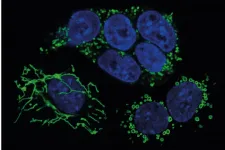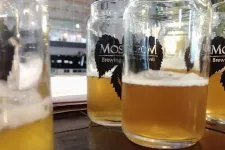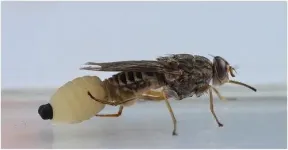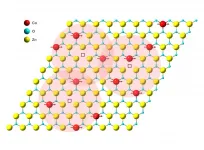Revealing the secrets of cell competition
2021-07-20
(Press-News.org) As multicellular life relies on cell-cell interactions, it is not surprising that this is not always peaceful: cells with higher fitness eliminate cells with lower fitness through cell competition. Cell competition has emerged as a quality control mechanism and occurs when cells differ, genetically or otherwise, from each other. In mammals, the process of cell competition has been observed e.g., in cancer, during organ homeostasis, and during development as a process to select the fittest cells in the embryo and the adult. However, the features that distinguish "winner" from "loser" cells and whether there are key determinants for cell competition in various biological contexts remain elusive.
The recipe for elimination of "loser" cells
The research team found out that the cells losing the competition are characterized by defective mitochondria and, in mouse embryos, they are marked by sequence changes in their mitochondrial genome. Their work was published in the journal Nature Metabolism. "Our work suggests that differences in mitochondrial activity are key determinants of competitive cell fitness in a wide range of systems. In particular, we discovered that genetic defects in the mitochondria characterize 'loser' cells in mouse embryos," says Antonio Scialdone, co-corresponding author of the article.
In more detail: The mouse embryo uses cellular competition to get rid of unfit epiblast cells before the basic body plan is laid down during gastrulation. Using single-cell RNAseq (a specific sequencing technique), the researchers compared cells in embryos treated with a cell death inhibitor versus those in untreated mouse embryos. By applying machine learning algorithms, they could identify the gene expression signature of "loser" cells and discovered that these cells have defective mitochondria and are marked by sequence changes in their mitochondrial genome. "It was nice to see how with our computational pipeline we were able to extract such important information from the single-cell RNAseq datasets," says Gabriele Lubatti co-first author of the article.
The information on how "loser" cells look like in the mouse embryo allowed them to determine a "loser" cell identity. By analyzing the mitochondrial activity in other cell competition models, they could identify that mitochondrial dysfunction is a common characteristic in different "loser" cells and that small changes in the mitochondrial DNA are enough to drive cell competition.
Future work
This study suggests that mitochondrial activity may be a key determinant of cellular fitness in a variety of contexts where competition between cells occurs. Environmental changes can strongly influence metabolism and mitochondria play a central role in this process. Therefore, it is possible that cellular competition and associated defects in the mitochondrial genome in response to certain environmental factors leads to the emergence of a particular genotype ("winner" cells). This implies that cellular competition could be a direct link between environment and genotype, which will be interesting to explore further.
INFORMATION:
About the people
Gabriele Lubatti and Antonio Scialdone are part of the Institute for Epigenetics and Stem Cells, Institute of Functional Epigenetics, and Institute of Computational Biology at Helmholtz Zentrum München. At Imperial College London, Tristan Rodriguez, from the National Heart & Lung Institute, led the study from the UK side.
Helmholtz Zentrum München
Helmholtz Zentrum München is a research center with the mission to discover personalized medical solutions for the prevention and therapy of environmentally-induced diseases and promote a healthier society in a rapidly changing world. It investigates major diseases which develop from the interaction of lifestyle, environmental factors and personal genetic background, focusing particularly on diabetes mellitus, allergies and chronic lung diseases. Helmholtz Zentrum München is headquartered in Neuherberg in the north of Munich and has about 2,500 staff members. It is a member of the Helmholtz Association, the largest scientific organization in Germany with more than 43,000 employees at 18 research centers.
[Attachments] See images for this press release:

ELSE PRESS RELEASES FROM THIS DATE:
2021-07-20
PULLMAN, Wash. - When it comes to craft beer, the flavor doesn't have to be all in the hops. As a panel of amateur beer tasters at Washington State University recently demonstrated, malted barley, the number one ingredient in beer besides water, can have a range of desirable flavors too.
Researchers recruited a panel of about 100 craft beer drinkers to taste some so-called SMaSH beers--those brewed with a single barley malt and single hop. All the beers contained the same hop variety, called Tahoma, but each had a malt from a different barley genotype, or genetic makeup. Trained tasters can distinguish these easily, but even the untrained ...
2021-07-20
An international group of researchers representing thousands of coral scientists across the globe is calling for new commitments and actions by the world's policymakers to protect and restore coral reefs.
In a paper presented July 20 at the International Coral Reef Symposium, the scientists said that the coming decade will likely offer the last chance for policymakers at all levels to prevent coral reefs "from heading towards world-wide collapse."
The paper, developed by the International Coral Reef Society, pushes for three strategies to save the reefs: addressing climate change, improving local conditions and actively restoring coral. ...
2021-07-20
The female tsetse fly, which gives birth to adult-sized live young, produce weaker offspring as they get older, and when they feed on poor quality blood.
The study, carried out by researchers at the Universities of Bristol, Oxford and the Liverpool School of Tropical Medicine, was designed to measure how tsetse offspring health is influenced by their mothers' age, and how factors such as the mother's nutrition and mating experience might come into play.
In many animals, females show signs of reproductive ageing - where offspring health declines with maternal age - but there is huge variation within species in how rapidly this ageing occurs.
Scientists found that female tsetse that experience ...
2021-07-20
For more than 20 years, Makoto Miyata from Osaka City University has been studying the gliding motility of the parasitic bacterium Mycoplasma mobile (M. mobile). It is a mechanism consisting of an external "grabbing" structure and internal "motor" - the motor having yet to be clarified on a molecular level. In collaboration with Osaka University and Kanazawa University, his research team used electron microscopy and high-speed atomic force microscopy (high-speed AFM) to reveal that the bacteria's molecular motor consists of two ATP synthase-like complexes, suggesting an unexpected evolution of the protein. Their findings were published in mBio.
Based on genetic information, researchers have suggested that the ...
2021-07-20
Imagine you're a CEO who wants to promote an innovative new product -- a time management app or a fitness program. Should you send the product to Kim Kardashian in the hope that she'll love it and spread the word to her legions of Instagram followers? The answer would be 'yes' if successfully transmitting new ideas or behavior patterns was as simple as showing them to as many people as possible.
However, a forthcoming study in the journal Nature Communications finds that as prominent and revered as social influencers seem to be, in fact, they are unlikely to change a person's behavior by example -- and might actually be detrimental to the cause.
Why?
"When social influencers present ideas that are ...
2021-07-20
A new scoping review found that those with chronic health concerns, such as diabetes, heart disease, cancer, and autoimmune conditions, are not only at a higher risk of severe COVID-19 infection, they are also more likely to experience anxiety, depression or substance use during the COVID-19 pandemic.
The aim of the review was to address knowledge gaps related to the prevention and management of mental health responses among those with chronic conditions. The findings, recently published in the International Journal of Environmental Research and Public Health, were based on a comprehensive review of 67 Chinese and English-language studies.
"Levels ...
2021-07-20
A recent study in Frontiers in Sustainable Food Systems shows that the fruits of a type of tomato plant send electrical signals to the rest of the plant when they are infested by caterpillars. Plants have a multitude of chemical and hormonal signaling pathways, which are generally transmitted through the sap (the nutrient-rich water that moves through the plant). In the case of fruits, nutrients flow exclusively to the fruit and there has been little research into whether there is any communication in the opposite direction--i.e. from fruit to plant.
"We usually forget that a plant's fruits are living and semiautonomous parts of their mother-plants, far ...
2021-07-20
ANN ARBOR, Mich. - As children made fewer visits to health facilities and engaged in social distancing and other COVID-19 mitigation measures, a smaller number of them also received prescription drugs, a new study suggests.
Overall, medications prescribed for children dropped by more than a quarter during the first eight months of the pandemic compared to the previous year, with the steepest declines in infection-related medicines like antibiotics and cough-and-cold drugs.
Antibiotic dispensing to children and teens plunged by nearly 56 % ...
2021-07-20
An internal transporter that enables us to use the copper we consume in foods like shellfish and nuts to enable a host of vital body functions also has the essential role of protecting the receptor that enables us to grow new blood vessels when ours become diseased, Medical College of Georgia scientists report.
The findings published in the journal END ...
2021-07-20
The development of an ultrathin magnet that operates at room temperature could lead to new applications in computing and electronics - such as high-density, compact spintronic memory devices - and new tools for the study of quantum physics.
The ultrathin magnet, which was recently reported in the journal Nature Communications , could make big advances in next-gen memories, computing, spintronics, and quantum physics. It was discovered by scientists at the Department of Energy's Lawrence Berkeley National Laboratory (Berkeley Lab) and UC Berkeley.
"We're ...
LAST 30 PRESS RELEASES:
[Press-News.org] Revealing the secrets of cell competition




